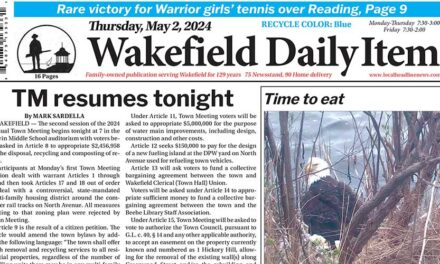Published in the February 14, 2018 edition
By MARK SARDELLA
WAKEFIELD — In an effort to meet the expectation that it limit its FY 2019 budget increase to 4 percent or less, the School Department appears poised to ask the town to fund a significant portion of the Special Education Budget outside of the regular School Department budget.
The proposal calls for the town to place at least $500,000 annually in a “Special Education Stabilization Account” outside of the School Department’s regular budget, with the expectation that the full amount would be used every year.
At last night’s School Committee meeting, School Superintendent Dr. Kim Smith outlined two possible approaches to the School budget for FY 2019 and beyond.
One would be the standard budget, which would include some unpredictable additional Special Education costs, including a bump in out-of-district placements. Done that way, Smith said, the requested FY 2019 budget would come with a 5.54 percent increase.
There is a reason that this has become a sensitive topic.
Last year, the School Department took considerable heat for coming in with an FY 2018 budget request that included a 4.7 percent increase. The reason many objected to that increase was because two years earlier, the town had agreed to bump the School Department’s budget by a one-time 11 percent to fund tuition-free, all day-kindergarten and to “right-size” some other budget areas. The stated trade-off was that the School Department would be expected to come in with increases of no more than 4 percent for at least the next three years.
Dr. Smith told the School Committee last night that she plans to present her full recommended FY 2019 School Department budget at the committee’s Feb. 27 meeting.
She said that a “level services” budget, with nothing added except items like negotiated, contractual salary increases, would already be at a 4.04 percent increase.
Smith said that she then asked her budget leaders to provide their requests for FY 2019, which, she said, would have brought the increase to over 8 percent. She said that she and her budget team then set about trimming and reorganizing in an effort to reduce that number.
She said that after the equivalent of four full-time staff positions were cut, along with several retirements, reductions in other areas and offsets from grants, she was able to get the increase down to 5.3 percent. But she noted that if Phase 2 of the planned user-fee reduction were to be implemented, it would bring the increase back up to 5.54 percent.
Smith then proposed another possible approach, which she called “Option B.”
She said that if $500,000 from the Special Education line item were taken out of the budget, the budget increase would go “right down to 3.98 percent.” She and School Business Administrator Michael Pfifferling explained that the state has been only reimbursing cities and towns for out-of-district Special Education costs at 65 percent instead of the 75 percent required by law. Plus, Wakefield has encountered a higher than expected number of out-of-district SPED placements.
That $500,000, they said, represents those out-of-district Special Education placements.
Under Option B, the School Department would be proposing to ask Town Meeting to separately place $500,000 in the Special Education Stabilization Account for FY 2019 and every year thereafter, with the expectation that that amount will be needed every year to fund out-of-district Special Education. The difference is that it would technically not be part of the school budget, enabling them to present smaller annual budget increases.
Smith added that even if the School Department decides to go with Option B, they will still be looking to take $175,000 out of the Special Education Stabilization account to fund a deficit in the current year’s Special Education budget. That request would fit within the original purpose that the fund was set up for, which was to help with unanticipated SPED costs.
But now the School Department is considering asking that that the town replenish the fund every year to the tune of at least $500,000 outside of the regular School Department budget, with the full expectation that the money will be needed every year for SPED costs. The $500,000, school administrators said last night, would represent the volatility and unpredictability of SPED costs, particularly out-of-district placements.
Pfifferling argued that, outside of the DPW’s snow and ice budget, no other town departments have anything as unpredictable – and costly – as SPED placements. He said that without the out-of-district SPED placements, over which the School Department has no control, the budget increase would be at 4 percent.
“This is a very transparent way of doing it,” he said.
School Committee member Anne-Marie Fortier noted that the out-of-district SPED placements must be funded by law.
“These are kids,” she said. “They have to have this.”
She stressed that the School Department would still be funding Special Education within its own budget, noting that the separate funding only applied to out-of-district SPED costs.
She said that the Option B approach made sense to her.
It was stressed that Option B would mean that the Special Education Stabilization Fund would no longer serve its original purpose as a “rainy day” fund. But rather, every year $500,000 to $600,000 would be put into the account by the town, outside of the School budget, with the knowledge and expectation that it is going to come right back out and be used to supplement the Special Education budget.
School Committee Chairman Rob Tiro called the proposal “a prudent budget plan” and “an innovative solution.”
Superintendent Smith said that she would be going before the Finance Committee on Thursday to get their feedback on the idea. She also asked School Committee members to get back to her in the next week with any additional thoughts that they might have.




